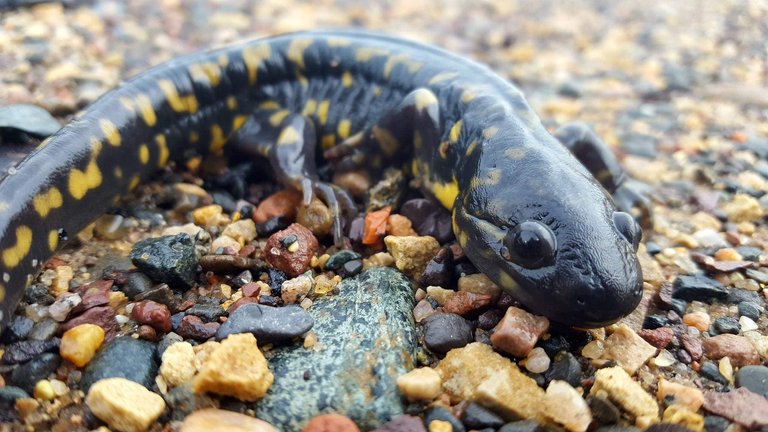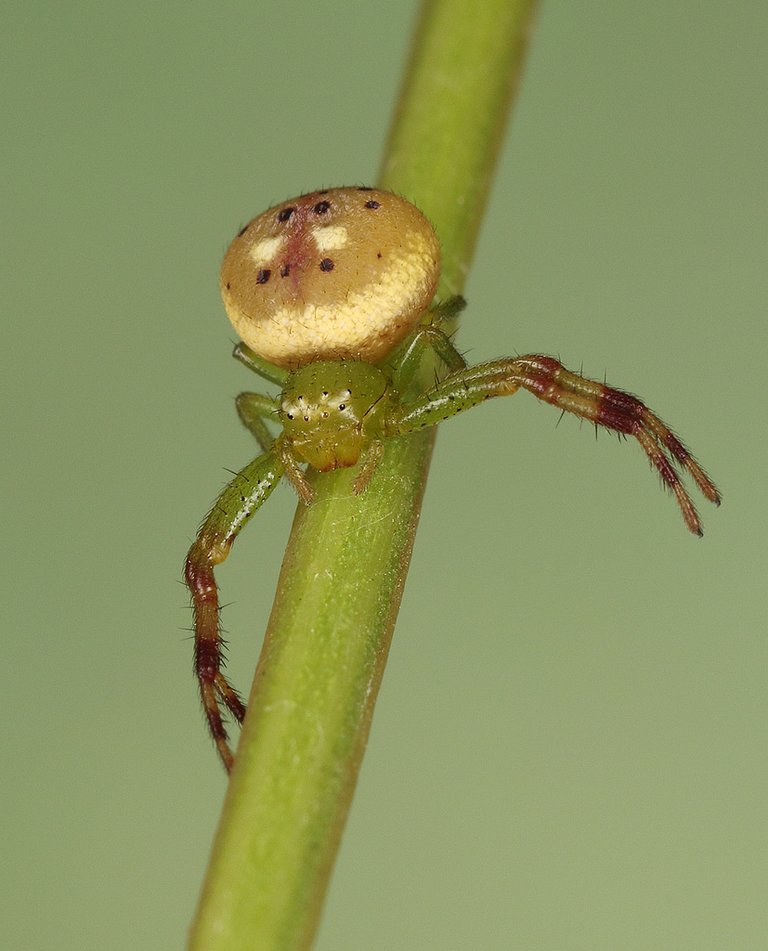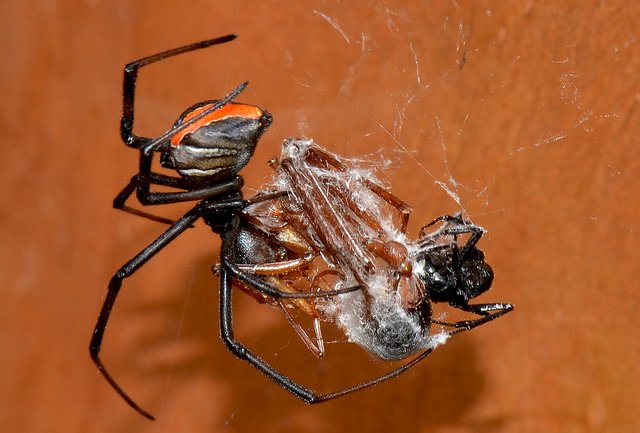
In the latest episode of “Animal Series”, I wrote about the tendency of a hippo to eat their own species when there were fewer foods. They need quite a lot of food to sustain their plushy figures (around 40 kg of grass per day) while living a sedentary life and the consequence of human’s activity like global warming can lead to a decrease in their food supply, increasing the likelihood for them to commit cannibalism. That's only one example of cannibalistic behaviour in an animal. In this article, I’m going to introduce to you, some other animals which have been committing cannibalism as part of their life.
Tiger Salamanders; Cannibalising for Extra Nutrients

The thing about cannibalism is, sometimes it changes the physical structures of the one who is committing it. For example, a cannibal tiger salamander can take up a much larger morph, having a stronger jaw which is equipped with a set of sharp teeth compared to the other non-cannibal version of the tiger salamander. In general, a tiger salamander can grow up to 40 cm in length and the difference between a cannibal and non-cannibal version of tiger salamander can be seen at its head. Most of the structural changes found on them were suited for preying upon another non-cannibal member of its species.
Overall, they were carnivorous amphibians. They usually prey upon small invertebrates such as worms or insects but sometimes, they were seen to eat some of the small frogs or even mice. Although they were considered amphibians, they spent most of their times on the land and only went into the water to either breed or if there are some circumstances which force them to do so (such as to escape from a predator). When it comes to reproduction, after mating, they (each gender) will deposit some of their sperms or ova at the bottom of the lake. The resulting fertilised ova will either yield a normal larva of tiger salamander or the cannibalistic one. How to differentiate them? Their size would be one of the parameters; the cannibal larvae is much larger than the normal larvae giving them some evolutionary advantage to devour the non-cannibal tiger salamander.
A paper published in 1994 by David W. Pfennig et al stated that a cannibal tiger salamander can still recognize the concept of kinship. When they were presented with choices between two tiger salamanders who are unrelated to them, they will take some time to choose which one is the viable target for food. If the choice is between one of its sibling with the other one being an unrelated salamander, then their decision becomes much simpler. They will rush to eat the unrelated salamander, sparing their sibling. I bet it was not an easy decision if the cannibal tiger salamander was presented with both of its siblings. When it comes to choosing between two siblings, they were more likely to devour the non-cannibal form of the tiger salamander, sparing the cannibal one.

So, how does this animal differentiate, which one is its sibling and which one is not? Well, the experiment conducted by David W. Pfennig has proved that smell is an important sense when it comes to identifying their own kin. When the cannibal tiger salamander's nose was being occluded, they will eat pretty much everything including their cannibal kin, which usually they avoid. The meat of the other tiger salamanders provides extra nutrients for the cannibal to grow. It was speculated that they were larger than the non-cannibal form of tiger salamanders due to their affinity to the flesh of their own kind. It's a scary fact but for a tiger salamander, eating their own kind provides them with a bunch of nutrients which otherwise can't be obtained from its normal diet.
Matriphagy; The Tale of a Crab Spider

What will you do to ensure the continuity of your generation? You might be willing to fight for your kids, putting yourself in a harm's way to protect them but will you give your own flesh and thus your life to ensure their survival? When it comes to the commitment of being a parent in the animal world, crab spiders (Diaea ergandros) is a wonderful mother. The principle that is held by this species of spider is different from any others; usually, we want to stay alive at all cost and dying to accomplish something is a rare thing to even be considered.
Matriphagy is a behaviour whereby the resulting offsprings consume their mother to survive. There are some spiders which have been practising matriphagy but one of the most common examples is the crab spider (Diaea ergandros). Nepotism or nepotistic recognition is an important feature of various animals in the animal kingdom to ensure the survivability of a species. I mean, you will not be a victim to a predator if you can recognise your own family in that regards. In crab spider, however, nepotism was never have been observed nor proven.
When the offsprings were committing matriphagy, the other spiderlings might want to come and feast upon someone's mothers. However, when the mother was being eaten by its own offspring, they will produce some kind of extra food storage in the form of ovaries to provide her spiderlings with extra nutrients. This will allow the offspring to consume more which will reduce the incidence of cannibalism between the siblings hence improving their chances of survival. I mean people love their kids in their own, twisted ways right?
Does the mother always die from matriphagy? Well, not necessarily, sometimes, they survive at the cost of their ability to reproduce. I mean, all of their ovaries have been eaten by their own offsprings right? An article which was published in 1998 by Theodore A. Evans has proved that the survival rate of a natural mother is much higher than an adopted mother. When it comes to factors which could hinder the spiderling from being a cannibal, the mother's weight is the most important one. It correlates with the duration of a spiderling being a non-cannibal creature. As long as they were feeding on their mother's ovaries, they will not turn cannibals.

An adopted mother, however, would not produce any ovaries which would act as a food storage for the recently hatched spiderlings. This results in a low-weight maternal spider which would result in low chances of survivability (the spiderlings would suck them until they dry). It's beautiful but at the same times, terrifying. The tendency for a spider to produce ovaries are low due to fact that they were usually live nearby to each other. The point I would like to make is, it will be rare for a spider to only feed their own offspring entirely, sometimes there were others so the number of ovaries produced was less than expected. This correlates with a high mortality rate among crab spiders.
Whatever the outcome is, I think we all can agree that they were kind-hearted enough to raise children which are not their own thus making them one of the most wonderful creatures on the planet who has been giving an extreme maternal care to their or anyone else's offsprings.
The Redback Spider; Engaging In A Reproductive Suicide
I have covered some information in my previous article regarding suicidal reproductive behaviour among some animals in the animal kingdom. If you haven't read the post, you can click the link below to find out:

The redback spider was named after the red stripe which can be found at the back of its black body. They are usually found in a warm area specifically in human's residences, waiting for prey to pass its trap at the corner of the wall. It usually targets some insects, any small vertebrates and occasionally some spiders. When they successfully caught their victims, they will bite the victim, paralysing them with some kind of venoms before squirting them with some form of a liquid, that resembles a superglue.
After its victim has been rendered immobilised, they will wait for its victim to struggle for minutes to hours (depending on the type of prey) before restraining them with a strong silk. The prey would be brought to the redback spider's nest to be engulfed and any remaining would be stolen by the male redback spider who was waiting at the periphery area of the web.
When a male redback spider has reached its sexual maturity, it would build a web in which he will deposit its own sperm before collecting it with the reproductive organ. It's like equipping your weapon with poisons. The reason why they were doing this is that the copulatory organ and their gonads were not connected. The only way they can create a functional sexual organ is by doing it manually; otherwise, their palps (the sexual organs) were non-functional (like your genital without sperms).

The female spider is equipped with two sperm-storage organs called the spermathecae. During reproduction, the male redback spider would attempt in inserting both of its palps into the female spermathecae. After the mating ritual, the male spider will quickly turn their abdomen to the female mouth allowing it to eat them. It's kind of odd since most of the animals which are known to involve in suicidal reproduction were unwillingly devoured by the female but in this case, the male spider assists by getting into a favourable position to be eaten. According to Andrade (2002), there are two purposes for committing such behaviour:
- It would extend the duration of sexual intercourse which means more sperms are being deposited and possibly fertilised
- If the male redback spider was eaten wholly, the female redback spider would reject the other male redback spiders in the future
If the male redback spider does not die from being eaten, they will die from the physical injury sustained during the sexual intercourse. Sounds familiar?
References and further reading materials
- Animal Cannibalism: Who Does It And Why. Retrieved on May 27th, 2018.
- Tiger salamander. Retrieved on May 27th, 2018.
- Redback spider. Retrieved on May 27th, 2018.
- Kin recognition and cannibalism in polyphenic salamanders. Retrieved on May 27th, 2018.
- Arachnid Matriphagy: These Spider Mothers Literally Die for Their Young. Retrieved on May 27th, 2018.
- Nature's Marvellous Mothers. Retrieved on May 27th, 2018.
- Offspring recognition by mother crab spiders with extreme maternal care. Retrieved on May 27th, 2018.
- Risky mate search and male self-sacrifice in redback spiders. Retrieved on May 27th, 2018.

SteemSTEM is a community project with the goal to promote and support Science, Technology, Engineering and Mathematics on the Steem blockchain. If you wish to support the steemSTEM project you can:
Contribute STEM content using the #steemstem tag | Support steemstem authors | Join our curation trail | Visit our Discord community | Delegate SP to steemstem




Cool and interesting article @chloroform!
I wonder why this happened? Perhaps because it is smaller than the cannibal one?
That might sound extreme for us "advanced" humans, but insect lives are so different, sometimes they eat their partners as in the case of spiders you mentioned, and this time, they might eat their mother... such is the dangerous life in the insect world. Good thing for us we don't need to do any of that in order to survive.
Size could be one of the factors but the experiment conducted by David Pfennig suggested that they recognise similarities between them with the others through their keen sense of smell. They would most likely to spare a tiger salamander who smell like a cannibal than the others who do not as they feel there is some sort of biological relationship which they interpreted as being one of their kin.
Some owls feed their weakest young to the rest of the owlets if there is a shortage of food (TT)
Well, I'm glad you survive then. XD
so a non-cannibal tiger salamander could produce both cannibal and non-cannibal salamander lavae when giving birth? The cannibal form comes from a gene which is sometimes expressed? Like the gene for red hair in humans?
@flyyingkiwi, that's how I understand it, so yeap.
You would be looking nervously over at any siblings that looked to be growing a bit bigger than normal
Hey @chloroform
This is for sure a masterpiece that can be consulted by research students. I have read about many situations that could lead to cannibalism but the one cited below is so unique...
What a sacrifice! This surely an extreme form of cannibalism. I guess I have learnt something great!
@eurogee of @euronation community
Matriphagy is one thing, mother eating their child is another. In matriphagy, the purpose of letting their kids to cannibalise their own flesh is to minimise the case of cannibalism between siblings while in the case of a mother eating their kids after they were born was to regain any nutrients they have otherwise lost during pregnancy. Both are considered extreme cases of cannibalism.
Sweetly put
Hey @chloroform
This is for sure a masterpiece that can be consulted by research students. I have read about many situations that could lead to cannibalism but the one cited below is so unique...
What a sacrifice! This surely an extreme form of cannibalism. I guess I have learnt something great!
@eurogee of @euronation community
My Cat :)

These creatures are really mysterious, eating one kind to survive is really scary. Especially the time salamander which gains more nutrients from consuming its kind.
Yes, they are. Thanks for reading it.
You are welcome.